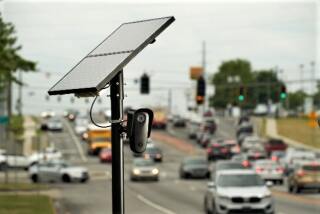Race Is On for Security Gear
- Share via
For a glimpse of airport security in the years to come, head to northern San Diego County.
A sea of office parks houses a handful of high-tech companies that are developing technology to ease business travelers’ journeys through airport security checkpoints and on to their destinations.
Drug sniffers, bomb detectors, passenger screeners, shoe scanners, fingerprint matchers and other equipment are all under study or in initial development.
In the end, it will be the Department of Homeland Security and its Transportation Security Administration that will determine which devices will be acquired or rejected.
The TSA earmarked $72 million for emerging checkpoint technologies in 2006, up from $28 million in 2005. And Homeland Security already was evaluating 13 devices for detecting liquid explosives before the Aug. 10 London terrorist threat.
Many of those ideas come from Southern California. On a recent Friday afternoon, I drove to northern San Diego County and toured three companies that are developing this technology.
The area gets a lot of tech start-ups because it is relatively inexpensive to do business in its many industrial parks.
“There is a lot of room to grow and rents are still very reasonable up there,” said Suzanne Finch, spokeswoman for the Center for Commercialization of Advanced Technology, Southern California. The center is an academic, industry and government partnership funded by the Pentagon and administered by San Diego State University and Cal State San Bernardino.
The center provides grants that help fast-track new technologies from small entrepreneurs, academic researchers and government lab scientists that have military, law enforcement and security uses, including those for airports.
It provided funding to the three companies visited.
My first stop was at Daylight Solutions, a molecular detection company tucked away in Poway. It has developed a battery-operated, hand-held laser device that, by measuring the reaction of molecules to laser light, can detect “molecules of interest” to security personnel, said Paul Larson, Daylight Solutions’ president. Essentially, he is saying the device can detect molecules contained in explosives, poisonous gases and illegal drugs.
The device could be waved over and around a traveler like a wand and can even detect “molecules of interest” hidden in water bottles, Larson said, adding that eventually you might be able to point it at a box from a distance to determine whether the contents were dangerous.
If all goes according to plan, the wands could be deployed at airports by 2008, Larson said.
Tim Day, Daylight Solutions’ chief executive, said that demand could be as many as 10,000 units per year, which would help keep the final cost down to about $1,000 per unit.
Down the road about five miles is the lab for GE Infrastructure Security (formerly Quantum Magnetics), a division of General Electric Co. It is here that a kiosk developed for the TSA’s oft-delayed Registered Traveler program was built.
Registered Traveler is a privately run program sponsored by the TSA that allows participants to use an expedited security lane if they pay a fee, submit their fingerprints and a scan of their iris and undergo a background check in advance.
It is currently operational only at Orlando (Fla.) International Airport, where the kiosk is being tested.
As I entered the lab, two men were assembling another one of the kiosks. It looks something like a treadmill, only without anything moving under your feet.
The kiosk is an assemblage of various technologies, some from the GE lab and others from off-the-shelf sources.
The components developed here include a shoe scanner that uses magnetic resonance to detect explosives or metallic weapons hidden in shoes while the traveler is wearing them, and the Itemiser FX, a device that can detect explosive residue on the fingertips of someone who has handled them.
Like the one in Orlando, this kiosk, which costs less than $200,000, not only checks passengers for potential threats but also verifies their identity by electronically scanning fingerprints and irises. Although the whole process takes less than a minute, it is not yet considered a viable solution to quickly screening large numbers of passengers.
Meanwhile, the shoe scanner component of the kiosk has been integrated into a separate walk-through device.
A passenger would step up to a clear plastic gate, have their shoes checked for trouble and, if all is well, the gate will open automatically about 10 seconds later allowing the traveler to pass.
The free-standing shoe scanner is a fully operational demonstration model. If ordered, it could be brought to commercial reality quickly, said Geoffrey Barrall, technology leader for GE Infrastructure Security.
My final stop was in Carlsbad at Seacoast Science Inc., where they have developed a hand-held “volatile organic chemical detector.”
It can detect a range of chemicals, including mustard gas, sarin and acetone, one of the components in the bombs used in last summer’s London subway bombings.
“Our biggest competition is a dog’s nose,” said Todd Milsna, Seacoast Science’s president. “That’s what we’re trying to replicate.”
The problems with many technologies that have been evaluated thus far have been with their performances outside the lab, said Christopher Kelly, spokesman for Homeland Security’s science and technology division.
“The current technology is not operationally viable,” he said. “There are shortfalls in processing speed, reliability and false alarms that need to be evaluated.”
After the London terror scare Aug. 10, the department sought proposals “from nontraditional vendors to provide us with information on technology that may be out there to help with this, and received 60 submittals,” Kelly said.
It may take months -- and in some cases years -- to properly evaluate and perhaps implement new security systems. In the meantime, we will be checking our bags and removing our shoes at security.
More to Read
Sign up for Essential California
The most important California stories and recommendations in your inbox every morning.
You may occasionally receive promotional content from the Los Angeles Times.










